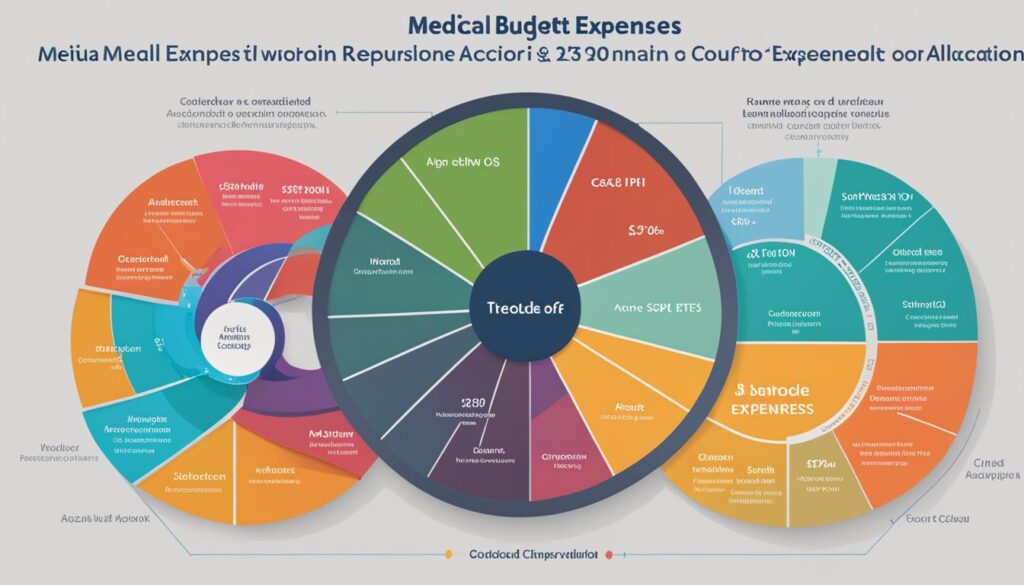Healthcare costs can be a significant financial burden, particularly in retirement. Planning for these expenses is crucial to ensure your financial well-being. In this article, we will explore the importance of budgeting for healthcare costs, including medical expenses and health insurance.
As you prepare for retirement, it’s essential to consider how decisions about your retirement age, Social Security benefits, and generating cash flow will affect your healthcare expenses. Additionally, understanding the limitations of Medicare coverage and the gap in saving for healthcare costs is vital.
To adequately budget for healthcare expenses, it may be beneficial to increase contributions to tax-advantaged accounts, such as Health Savings Accounts (HSAs). These accounts offer tax benefits and can help offset medical costs. It’s also crucial to be aware that Medicare may not cover all healthcare expenses in retirement, so having additional savings is essential.
Key Takeaways:
- Budgeting for healthcare costs is crucial for financial planning, especially in retirement.
- Consider increasing contributions to tax-advantaged accounts like HSAs to save for medical expenses.
- Be aware that Medicare may not cover all healthcare costs in retirement.
- Planning for the gap in saving for healthcare expenses is essential.
- Healthcare costs can be a significant expense in retirement, so it’s vital to prepare accordingly.
Understanding Your Retirement Health Care Costs
When planning for retirement, it’s crucial to consider the costs associated with health care. Retirement health care costs are expected to be one of the largest expenses, influenced by factors like increased life expectancy, health care inflation, and the average retirement age being 62. While many individuals assume that Medicare will cover all health care expenses in retirement, this is not the case. It’s important to have a clear understanding of your retirement health care costs and take proactive steps to prepare for them.
Fidelity’s Retiree Health Care Cost Estimate provides valuable insights into the savings needed for health care expenses in retirement. According to their estimate, a single person retiring at age 65 may need approximately $157,500 saved to cover health care costs in retirement. This estimate highlights the importance of saving and budgeting for health care throughout your working years to ensure financial stability during retirement.
To save for health care expenses in retirement, it’s advisable to consider increasing contributions to tax-advantaged accounts, such as Health Savings Accounts (HSAs). These accounts offer tax benefits and allow individuals to set aside funds specifically for health care. By contributing to an HSA, you can save for future medical expenses and reduce your taxable income. Understanding your retirement health care costs and taking advantage of tax-advantaged accounts can help ensure that you’re financially prepared for your health care needs in retirement.
Understanding Your Retirement Health Care Costs
Retirement health care costs can significantly impact your overall financial well-being in retirement. By understanding these costs and taking the necessary steps to save for them, you can achieve greater peace of mind and financial security during your golden years.
Preparing for Retirement Health Care Costs
As retirement nears, it’s important to make key decisions about when to stop working, when to take Social Security, and how to pay for health care. Many early retirees claim Social Security at age 62 to help cover health care expenses until they are eligible for Medicare at age 65. However, delaying retirement or saving enough to cover health care costs until Medicare eligibility can allow for higher Social Security benefits. It’s important to explore health insurance options before reaching Medicare eligibility, such as COBRA continuation, spouse’s health plan, public marketplace, and private insurance. Additionally, understanding Medicare options and considering supplemental insurance plans, such as Medigap policies, is crucial when turning 65 and retiring.
Health Insurance Options Before Medicare Eligibility
Before turning 65 and becoming eligible for Medicare, it’s essential to consider health insurance options that can bridge the gap and provide coverage. Here are some options to explore:
- COBRA continuation: If you leave your job before reaching Medicare eligibility, you may be able to continue your employer-sponsored health insurance coverage through COBRA. Keep in mind that COBRA coverage can be expensive, as you’ll be responsible for the full premium.
- Spouse’s health plan: If your spouse continues to work and has health insurance coverage, you may be able to join their plan until Medicare kicks in. Be sure to review the costs and coverage details.
- Public marketplace: The Affordable Care Act established public health insurance marketplaces where you can purchase coverage if you don’t qualify for other options. You can compare plans and choose one that suits your needs and budget.
- Private insurance: Consider private health insurance plans available in your area. These plans may offer various coverage options and premiums, so it’s important to carefully evaluate their benefits and costs.
Understanding Medicare Options and Supplemental Insurance
When you turn 65 and become eligible for Medicare, it’s crucial to understand the different Medicare options and consider supplemental insurance plans to enhance your coverage. Here’s an overview of the main Medicare components:
| Medicare Part A | Medicare Part B | Medicare Part C (Medicare Advantage) | Medicare Part D |
|---|---|---|---|
| Covers hospital services, skilled nursing facility care, hospice care, and some home health care. | Covers doctor visits, outpatient care, preventive services, and medical equipment. | Private insurance plans that combine Parts A, B, and often D. They may offer additional benefits like dental and vision coverage. | Coverage for prescription drugs. It can be added to original Medicare or obtained through a Medicare Advantage plan. |
It’s important to evaluate your health care needs, budget, and desired level of coverage when choosing between original Medicare and Medicare Advantage. Additionally, considering supplemental insurance plans, such as Medigap policies, can help cover costs that Medicare doesn’t fully pay for. Medigap plans are offered by private insurers and can help with copayments, deductibles, and other out-of-pocket expenses.
Budgeting Your Medical Expenses
When it comes to managing your healthcare costs, budgeting is crucial. By carefully planning and allocating your financial resources, you can effectively navigate the expenses associated with medical care. To help you get started, here are some key considerations for budgeting your medical expenses:
Fixed Monthly Premiums
Fixed monthly premiums are a significant aspect of healthcare expenses. These are the regular payments made to your insurance provider for coverage. When budgeting, it’s important to factor in these premiums, which typically account for around 4 to 6 percent of your monthly net income. By allocating the appropriate amount for premiums, you can ensure that you have consistent coverage for your medical needs.
Routine Out-of-Pocket Expenses
In addition to fixed premiums, it’s essential to budget for routine out-of-pocket expenses. These may include costs for prescription drugs, preventive care, and other recurring healthcare needs. It is advisable to allocate approximately 2 to 8 percent of your monthly net income for these expenses. By setting aside the necessary funds, you can manage these routine costs without financial strain.
Unexpected Costs
While it’s difficult to anticipate every healthcare expense, it’s crucial to budget for unexpected costs. Medical emergencies and unforeseen circumstances can result in unforeseen expenses that can significantly impact your finances. To prepare for such situations, consider setting aside extra money in your budget. Additionally, health savings accounts (HSAs) and flexible spending accounts (FSAs) are valuable tools that can help you offset these unexpected costs.
By carefully budgeting for your medical expenses, you can be prepared for the costs associated with healthcare. Whether it’s setting aside funds for fixed monthly premiums, allocating a budget for routine out-of-pocket expenses, or preparing for unexpected costs, a well-planned budget can provide financial stability and peace of mind in managing your healthcare needs.

Maximizing Health Savings Accounts and Flexible Spending Accounts
Health savings accounts (HSAs) and flexible spending accounts (FSAs) are valuable tools for budgeting healthcare costs. These accounts allow individuals to set aside money specifically for healthcare expenses and offer tax benefits and reduced paperwork. By understanding the benefits and features of HSAs and FSAs, individuals can make the most of these accounts to effectively budget for their healthcare needs.
Health Savings Accounts (HSAs)
HSAs are tax-advantaged accounts that individuals can contribute to on a pre-tax basis. The funds in an HSA can be used to pay for qualified medical expenses, such as doctor visits, prescriptions, and medical equipment. One of the key benefits of an HSA is that the contributions are tax-deductible, meaning individuals can reduce their taxable income by contributing to their account. Additionally, the funds in an HSA can be invested and grow tax-free, providing an opportunity for long-term savings.
To maximize the benefits of an HSA, it’s important to contribute the maximum allowed amount each year. For 2021, the maximum contribution for an individual is $3,600, and for a family, it’s $7,200. By contributing the maximum amount, individuals can take full advantage of the tax benefits and ensure they have sufficient funds for healthcare expenses.
Flexible Spending Accounts (FSAs)
FSAs are another tax-advantaged account that individuals can use to save for healthcare expenses. Unlike HSAs, FSAs are typically offered through an employer and funded with pre-tax dollars through a payroll deduction. The funds in an FSA can be used for qualified medical expenses, such as copayments, deductibles, and prescription medications.
It’s important to note that FSAs have a “use it or lose it” provision, meaning any funds not used by the end of the plan year are forfeited. However, some employers may offer a grace period or a carryover option, allowing individuals to use the funds beyond the plan year. To maximize the benefits of an FSA, it’s essential to estimate healthcare expenses accurately and only contribute what you expect to use during the plan year.
Comparison of HSAs and FSAs
| Feature | Health Savings Accounts (HSAs) | Flexible Spending Accounts (FSAs) |
|---|---|---|
| Tax Benefits | Contributions are tax-deductible; earnings grow tax-free; withdrawals for qualified medical expenses are tax-free | Contributions are made with pre-tax dollars; withdrawals for qualified medical expenses are tax-free |
| Contribution Limits (2021) | $3,600 for individuals; $7,200 for families | $2,750 |
| Investment Options | Can invest funds and grow savings tax-free | N/A |
| Expiration of Funds | Remain in the account until used; no year-to-year expiration | Use it or lose it; some employers offer a grace period or carryover option |
By understanding the differences between HSAs and FSAs, individuals can choose the account that best suits their needs. Both HSAs and FSAs provide a way to save for healthcare expenses while enjoying tax benefits. Consider your personal financial situation and healthcare needs to determine which account is right for you.
Maximizing health savings accounts and flexible spending accounts is an effective way to budget for healthcare expenses. By taking advantage of the tax benefits and carefully planning contributions, individuals can ensure they have the necessary funds to cover their healthcare needs. Additionally, reducing paperwork and simplifying the reimbursement process make HSAs and FSAs convenient and user-friendly options for healthcare budgeting.

Choosing the Right Budgeting Approach
When it comes to budgeting for healthcare, there are different approaches to consider. Each approach has its own advantages and disadvantages, and the choice depends on the specific goals and needs of your department or organization. Here are some popular budgeting strategies to consider:
Incremental Budgeting
Incremental budgeting involves making small adjustments to the previous year’s budget. It is a simple and practical approach that allows for easy comparison and minimizes disruption. However, it can also lead to incrementalism and the perpetuation of inefficiencies or outdated spending habits.
Zero-Based Budgeting
Zero-based budgeting starts from scratch each budget cycle. It requires a thorough review of every expense and justifies the need for each item in the budget. This approach encourages a more critical evaluation of spending priorities and can lead to greater cost savings. However, it can be time-consuming and may require significant effort to implement initially.
Top-Down Budgeting
Top-down budgeting involves senior management setting the budget based on overall organizational goals and objectives. It provides a clear direction for budgeting and allows for centralized control. However, this approach may lack input from those responsible for delivering the service, which can lead to a lack of buy-in and potentially unrealistic targets.
Participatory Budgeting
Participatory budgeting involves input from those responsible for delivering the service. It encourages collaboration and engagement from various stakeholders, leading to a sense of ownership and improved implementation. However, this approach can be time-consuming and requires effective communication and coordination.
| Budgeting Approach | Advantages | Disadvantages |
|---|---|---|
| Incremental Budgeting | Simple and practical | Potential perpetuation of inefficiencies |
| Zero-Based Budgeting | Thorough evaluation of spending priorities | Time-consuming to implement |
| Top-Down Budgeting | Clear direction and centralized control | Lack of input from service deliverers |
| Participatory Budgeting | Collaboration and sense of ownership | Time-consuming and requires coordination |
Choosing the right budgeting approach depends on various factors, such as the complexity of your organization, the level of flexibility required, and the desired level of stakeholder involvement. It’s important to carefully consider the pros and cons of each approach and choose the one that aligns best with your department’s goals and needs.
Conclusion
Budgeting for healthcare is an essential aspect of financial planning, particularly when it comes to retirement. Understanding the potential medical expenses you may encounter and having a budget in place for fixed premiums, routine out-of-pocket costs, and unexpected fees can help ensure your financial well-being. By taking a proactive approach to budgeting for healthcare, you can better prepare for these expenses and safeguard your financial future.
Financial planning for retirement should include a comprehensive strategy for addressing healthcare costs. Considering options like health savings accounts (HSAs) and flexible spending accounts (FSAs) can provide the flexibility and financial security needed to cover healthcare needs in retirement. These accounts offer tax benefits and reduced paperwork, making them valuable tools for budgeting healthcare expenses.
By incorporating budgeting for healthcare into your overall financial plan, you can ensure that you are prepared for the costs associated with medical care. Whether it’s saving for retirement or navigating the complexities of healthcare expenses, taking a proactive and informed approach to budgeting is key. By doing so, you can achieve greater peace of mind and financial stability throughout your retirement years.
FAQ
What are some key factors to consider when budgeting for healthcare costs in retirement?
It’s important to plan for the gap in saving for healthcare costs, consider increasing contributions to tax-advantaged accounts like HSAs, and understand that Medicare may not cover all healthcare costs in retirement.
How much should I save to cover healthcare expenses in retirement?
According to Fidelity’s Retiree Health Care Cost Estimate, a single person age 65 may need approximately $157,500 saved to cover health care expenses in retirement.
Does Medicare cover all healthcare costs in retirement?
No, Medicare does not cover all healthcare costs in retirement. It’s important to carefully weigh all options and consider increasing contributions to tax-advantaged accounts, such as HSAs, to save for health care expenses in retirement.
What are some health insurance options before reaching Medicare eligibility?
Some health insurance options before reaching Medicare eligibility include COBRA continuation, spouse’s health plan, public marketplace, and private insurance.
What should I consider when turning 65 and retiring?
When turning 65 and retiring, it’s important to understand Medicare options and consider supplemental insurance plans, such as Medigap policies, to ensure comprehensive coverage.
How should I budget for medical expenses?
When budgeting for medical expenses, it’s important to consider fixed monthly premiums, routine out-of-pocket expenses, and unexpected costs.
What are health savings accounts (HSAs) and flexible spending accounts (FSAs) and how can they help budget for healthcare costs?
HSAs and FSAs are valuable tools for budgeting healthcare costs. They allow individuals to set aside money specifically for healthcare expenses and offer tax benefits and reduced paperwork.
What are some different approaches to budgeting for healthcare?
Different approaches to budgeting for healthcare include incremental budgeting, zero-based budgeting, top-down budgeting, and participatory budgeting. Each approach has its advantages and disadvantages, and it’s important to choose the one that best aligns with your goals and needs.
How can I best prepare for healthcare costs in retirement?
By taking a proactive approach to budgeting for healthcare, considering tax-advantaged accounts, and exploring insurance options, you can better prepare for healthcare costs in retirement and ensure your financial well-being. Additionally, it’s important to regularly review and adjust your budget to account for any changes in your health or healthcare policies. Engaging with a financial advisor can also provide valuable insights into peace of mind insurance strategies that can safeguard your retirement savings against unexpected medical expenses. By prioritizing these considerations, you can create a robust plan that supports not only your health but also your financial security in the years to come.
Can I Include Pet Healthcare Costs in my Budget for my Pets?
When considering budgeting for your pets, it’s essential to include healthcare costs. Taking care of your pets’ health should always be a priority, and this includes regular check-ups, vaccinations, and any unforeseen medical emergencies. By factoring in pet healthcare expenses into your budget, you can ensure the well-being of your furry companions while maintaining financial stability.

